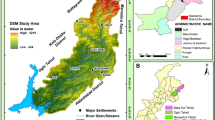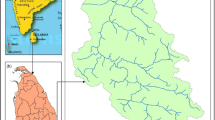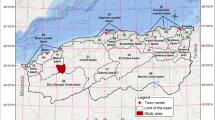Abstract
In the current times, anthropogenic activities and natural change in the processes cause much change in the world, causing multiple hazards and disturbing the natural flow. One such hazard is soil erosion, which is increasing day by day due to changes in climate and anthropogenic activities. Thus, identifying the soil erosion vulnerable zones and map such regions is extremely useful for the town and land planning. Such soil vulnerability mapping gives a quantifiable and reliable method to evaluate soil erosion in a wide variety of circumstances. In the current research, the soil erosion method, revised universal soil loss equation (RUSLE) integrated with geographic information system (GIS), has been applied for soil erosion approximation in the Rawalpindi Tehsil situated in the province of Punjab in the northeast part of Pakistan. The Rawalpindi metropolis is a semi-arid area with a drainage area of 259 km2 up to the gauging station. The datasets of the RUSLE model were valued from the remote sensing data, and the probable soil loss regions were estimated with the help of GIS. All the datasets, i.e., slope, soil, precipitation, crop management factor, was then used for soil erosion potential mapping. The potential map is generated from the weighted overlay method that gives an output showing that most of the study area is in medium (67.2%) to high (20.2%) erosion zone with erosion intensities of < 20 tons ha−1 year−1 and < 40 tons ha−1 year−1 respectively. Concurrently, few patches lie in high potential zones that need to be looked after and need to be pondered in terms of mitigation measures. Accuracy assessment for land-use and land-cover classes for the Rawalpindi watershed was also accomplished by comparing ground-truth with satellite data, and the Kappa coefficient of the agreement was also obtained. The overall accuracy was 85%, and the Kappa coefficient was found to be 84%, inferring the acceptability of results. Few mitigation solutions have also been described in this study, which might be helpful to minimize erosion. This research provides a positive impact on the execution of soil management and preservation practices to lessen the erosion of the soil in the Tehsil Rawalpindi.










Similar content being viewed by others
References
Abebe ZD, Sewnet MA (2014) Adoption of soil conservation practices in north Achefer district, northwest Ethiopia. Chin J Popul Resour Environ 12(3):261–268
Adam AHM et al (2013) Accuracy assessment of land use & land cover classification (LU/LC), case study of Shomadi area, Renk County, Upper Nile State, South Sudan. Int J Sci Res Publ 3:1–6
Angima S et al (2003) Soil erosion prediction using RUSLE for central Kenyan highland conditions. Agric Ecosyst Environ 97(1–3):295–308
Ashraf A et al (2017) Modeling risk of soil erosion in high and medium rainfall zones of Pothwar region, Pakistan. Proc Pak Acad Sci Pak Acad Sci B Life Environ Sci 54(2):67–77
Aslam B, Naseer F (2020) A statistical analysis of the spatial existence of earthquakes in Balochistan: clusters of seismicity. Environ Earth Sci 79(1):41
Aslam B, Muhammad J, Muhammad ZI, Gulraiz A, Quaid IA (2017) GIS mapping of tsunami susceptibility: case study of the Karachi City in Sindh. Pak J Geogr Nat Disast 7(187):2167–2587
Aslam B, Maqsoom A, Kazmi ZA, Sodangi M, Anwar F, Bakri MH et al (2020a) Effects of landscape changes on soil erosion in the built environment: application of geospatial-based RUSLE technique. Sustainability 12(15):5898
Aslam B, Ismail S, Maqsoom A (2020b) Geospatial mapping of Tsunami susceptibility of Karachi to Gwadar coastal area of Pakistan. Arab J Geosci 13(17):1–12
Aslam B, Ismail S, Ali I (2020c) A GIS-based DRASTIC model for assessing aquifer susceptibility of Safdarabad Tehsil, Sheikhupura District, Punjab Province, Pakistan. Model Earth Syst Environ 6:995–1005. https://doi.org/10.1007/s40808-020-00735-8
Aster D (2004) Use of geospatial technologies for environmental protection in Ethiopia. Environmental Protection Authority. United Nations/European Space Agency/Sudan. Remote sensing workshop on the use of space technology for natural resources management environmental monitoring and disaster management
Bai ZG et al (2008) Proxy global assessment of land degradation. Soil Use Manag 24(3):223–234
Benchettouh A et al (2017) Spatial estimation of soil erosion risk using RUSLE/GIS techniques and practices conservation suggested for reducing soil erosion in Wadi Mina watershed (northwest, Algeria). Arab J Geosci 10(4):79
Claessens L et al (2008) Mapping potential soil erosion in East Africa using the Universal Soil Loss Equation and secondary data. IAHS Publ 325:398
Cohen J (1960) A coefficient of agreement for nominal scales. Educ Psychol Meas 20(1):37–46
Dabral P et al (2008) Soil erosion assessment in a hilly catchment of North Eastern India using USLE, GIS and remote sensing. Water Resour Manag 22(12):1783–1798
Desmet P, Govers G (1996) A GIS procedure for automatically calculating the USLE LS factor on topographically complex landscape units. J Soil Water Conserv 51(5):427–433
Dunn M, Hickey R (1998) The effect of slope algorithms on slope estimates within a GIS. Cartography 27(1):9–15. https://doi.org/10.1080/00690805.1998.9714086
Fayas CM et al (2019) Soil loss estimation using rusle model to prioritize erosion control in KELANI river basin in Sri Lanka. Int Soil Water Conserv Res 7(2):130–137
Fernandez C et al (2003) Estimating water erosion and sediment yield with GIS, RUSLE, and SEDD. J Soil Water Conserv 58(3):128–136
FES (2009) Assessment of soil erosion in selected micro-watersheds in Koraput district, Orissa. Foundation for Ecological Security Report, Anand, India
Galdino S et al (2016) Large-scale modeling of soil erosion with RUSLE for conservationist planning of degraded cultivated Brazilian pastures. Land Degrad Dev 27(3):773–784
Ganasri B, Ramesh H (2016) Assessment of soil erosion by RUSLE model using remote sensing and GIS-A case study of Nethravathi Basin. Geosci Front 7(6):953–961
Gunawan G et al (2013) Soil erosion estimation based on GIS and remote sensing for supporting integrated water resources conservation management. Int J Tecnol 4(2):157–166
Hickey R (2000) Slope angle and slope length solutions for GIS. Cartography 29(1):1–8
Huffman GJ, Adler RF, Arkin PA, Chang A, Ferraro R, Gruber A, Janowiak JJ, Joyce RJ, McNab A, Rudolf B, Schneider U, Xie P (1997) The Global Precipitation Climatology Project (GPCP) combined precipitation data set. Bull Am Meteorol Soc 78:5–20
Huffman GJ, Adler RF, Morrissey MM, Curtis S, Joyce RJ, McGavock B, Susskind J (2001) Global precipitation at one-degree daily resolution from multi-satellite observations. J Hydrometeorol 2:36–50
Hurni H (1985a) Soil conservation manual for Ethiopia. First Draft. Ministry of Agriculture. Natural Resources Conservation and Development Main Department, Community Forests and Soil Conservation Development Department. Addis Abeba, Ethiopia
Hurni H (1985b) Erosion–productivity–conservation systems in Ethiopia. Paper presented at the 4th international conference on soil conservation, 3–9 November 1985, Maracacy, Venezuela
Khan AA et al (2019) Spatial trends in surface runoff and influence of climatic and physiographic factors: a case study of watershed areas of Rawalpindi district. Soil Environ. https://doi.org/10.25252/SE/19/81787
Kim H (2006) Soil erosion modeling using RUSLE and GIS on the IMHA Watershed. South Korea, Master Thesis. Colorado State University, Colorado
Labrière N et al (2015) Soil erosion in the humid tropics: a systematic quantitative review. Agric Ecosyst Environ 203:127–139
Laflen JM, Moldenhauer WC (2003) Pioneering soil erosion prediction: the USLE story. In: Michael A (ed) World association of soil and water conservation special publication No. 1
Maetens W et al (2012) Effects of land use on annual runoff and soil loss in Europe and the Mediterranean: a meta-analysis of plot data. Prog Phys Geogr 36(5):599–653
Maqsoom A, Rashid HB, Aslam B, Ashraf H, Abid M, Ejaz A (2020a) Building information modeling application for groundwater recharge: development of multiple structures. Environ Eng Manag J (EEMJ) 19(16)
Maqsoom A, Aslam B, Hassan U, Kazmi ZA, Sodangi M, Tufail RF, Farooq D (2020b) Geospatial assessment of soil erosion intensity and sediment yield using the revised universal soil loss equation (RUSLE) model. ISPRS Int J Geoinf 9(6):356
Maqsoom A, Aslam B, Khalil U, Ghorbanzadeh O, Ashraf H, Faisal Tufail R et al (2020c) A GIS-based DRASTIC model and an adjusted DRASTIC model (DRASTICA) for groundwater susceptibility assessment along the China-Pakistan economic corridor (CPEC) route. ISPRS Int J Geoinf 9(5):332
Mekuriaw A (2017) Assessing the effectiveness of land resource management practices on erosion and vegetative cover using GIS and remote sensing techniques in Melaka watershed, Ethiopia. Environ Syst Res 6(1):16
Mitasova H, Mitas L (1999) Modeling soil detachment with RUSLE 3d using GIS. University of Illinois at Urbana-Champaign
Mitasova H et al (1996) Modelling topographic potential for erosion and deposition using GIS. Int J Geogr Inf Syst 10(5):629–641
Moges DM, Bhat HG (2017) Integration of geospatial technologies with RUSLE for analysis of land use/cover change impact on soil erosion: case study in Rib watershed, north-western highland Ethiopia. Environ Earth Sci 76(22):765
Molla T, Sisheber B (2017) Estimating soil erosion risk and evaluating erosion control measures for soil conservation planning at Koga watershed in the highlands of Ethiopia. Solid Earth 8(1):13
Moore I, Burch G (1986a) Modelling erosion and deposition: topographic effects. Trans ASAE 29(6):1624–1630
Moore ID, Burch GJ (1986b) Physical basis of the length-slope factor in the universal soil loss equation 1. Soil Sci Soc Am J 50(5):1294–1298
Moore ID, Wilson JP (1992) Length-slope factors for the Revised Universal Soil Loss Equation: simplified method of estimation. J Soil Water Conserv 47(5):423–428
Morgan RPC (2009) Soil erosion and conservation. John Wiley & Sons, Hoboken
Nyesheja EM et al (2019) Soil erosion assessment using RUSLE model in the Congo Nile Ridge region of Rwanda. Phys Geogr 40(4):339–360
Nyssen J et al (2004) The effectiveness of loose rock check dams for gully control in Tigray, northern Ethiopia. Soil Use Manag 20(1):55–64
Panagos P et al (2015) Estimating the soil erosion cover-management factor at the European scale. Land Use Policy 48:38–50
PHAM TN et al (2003) Global soil loss estimate using Rusle model: the use of global spatial datasets on estimating erosive parameters. Geoinformatics 14(1):49–53
Prasannakumar V et al (2012) Estimation of soil erosion risk within a small mountainous sub-watershed in Kerala, India, using Revised Universal Soil Loss Equation (RUSLE) and geo-information technology. Geosci Front 3(2):209–215
Renard K et al (1996) USDA-ARS Agriculture Handbook No. 703: predicting soil erosion by water–a guide to conservation planning with the revised universal soil loss equation (RUSLE). Soil and Water Conservation Society, Ankeny, IA
Reusing M et al (2000) Modelling soil loss rates in the Ethiopian Highlands by integration of high resolution MOMS-02/D2-stereo-data in a GIS. Int J Remote Sens 21(9):1885–1896
Robert P, Hilborn D (2000) Factsheet: universal soil loss equation (USLE). Index No-572/751, Queen’s printer for Ontario, pp 35–36
Simms AD, Woodroffe CD, Jones BG (2003) Application of RUSLE for erosion management in a coastal catchment, southern NSW. In: Proceedings of MODSIM 2003 (Townsville, Queensland, Australia), pp. 678–683
Smith H (1999) Application of empirical soil loss models in southern Africa: a review. S Afr J Plant Soil 16(3):158–163
Tamene L et al (2006) Analysis of factors determining sediment yield variability in the highlands of northern Ethiopia. Geomorphology 76(1–2):76–91
Tirkey AS et al (2013) Use of satellite data, GIS and RUSLE for estimation of average annual soil loss in Daltonganj watershed of Jharkhand (India). J Remote Sens Technol 1(1):20–30
Toubal AK et al (2018) Soil erodibility mapping using the RUSLE model to prioritize erosion control in the Wadi Sahouat basin, North-West of Algeria. Environ Monit Assess 190(4):210
Ullah S et al (2018) Geospatial assessment of soil erosion intensity and sediment yield: a case study of Potohar Region, Pakistan. Environ Earth Sci 77(19):705
Van Remortel RD et al (2001) Estimating the LS factor for RUSLE through iterative slope length processing of digital elevation data within Arclnfo grid. Cartography 30(1):27–35
Van Remortel RD et al (2004) Computing the LS factor for the Revised Universal Soil Loss Equation through array-based slope processing of digital elevation data using a C++ executable. Comput Geosci 30(9–10):1043–1053
Wischmeier WH, Smith DD (1978) Predicting rainfall erosion losses: a guide to conservation planning. Department of Agriculture, Science and Education Administration
Yue-Qing X et al (2008) Adapting the RUSLE and GIS to model soil erosion risk in a mountains karst watershed, Guizhou Province, China. Environ Monit Assess 141(1–3):275–286
Zhang H et al (2013) Extension of a GIS procedure for calculating the RUSLE equation LS factor. Comput Geosci 52:177–188
Author information
Authors and Affiliations
Corresponding author
Additional information
Publisher's Note
Springer Nature remains neutral with regard to jurisdictional claims in published maps and institutional affiliations.
Rights and permissions
About this article
Cite this article
Khalil, U., Aslam, B. Geospatial-based soil management analysis using novel technique for better soil conservation. Model. Earth Syst. Environ. 8, 259–275 (2022). https://doi.org/10.1007/s40808-020-01078-0
Received:
Accepted:
Published:
Issue Date:
DOI: https://doi.org/10.1007/s40808-020-01078-0




